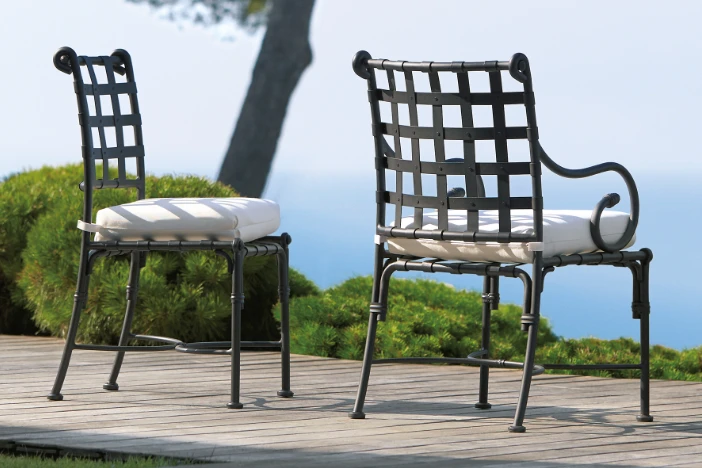
Properly cleaning & caring for patio furniture
High-quality outdoor furniture is built to weather the elements for years. That doesn’t mean that a little TLC can’t help to extend its useful life and keep it looking great longer. Taking care of these items doesn’t have to be hard. You just need to know how to clean and care for different materials. It also helps to commit to doing this regularly throughout the year. This guide provides tips for looking after your patio furnishings beyond just using mild dish soap and water. However, always consult manufacturers’ manuals for the best care of your specific products.
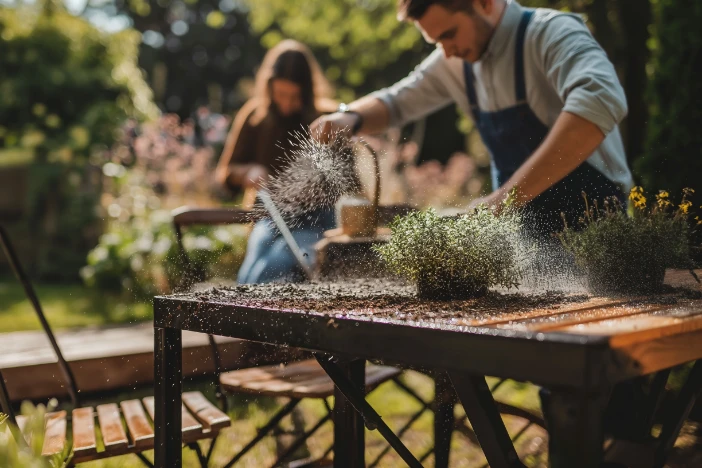
Deck furniture is going to get dirty
No matter how careful you are, something is bound to spill on your deck furniture. Maybe someone spills guacamole on the cushions of your sectional sofa. Or they tip over a glass of wine on the dining table on your screened-in porch. Suntan lotion will get wiped onto poolside sunloungers at some point. Those are just some of the ways people can muck up your pristine outdoor setting. Mother nature has plenty of tactics too. Wind, rain, sun, trees, bugs, birds, and other things can dirty and damage your furniture. You need to take steps to prevent this and clean it often. However, garden furniture cleaning isn’t a “one size fits all” situation. Woods, metals and plastics all need different attention.
Why regular outdoor furniture maintenance matters
Regular maintenance is not just about making your furniture look good. It also helps protect your investment and your health. Here are key reasons why consistent care is essential:
- Hygiene & Health
Regular cleaning helps prevent the buildup of mold, mildew, bacteria, and allergens. Left unchecked, these can lead to unpleasant odors, surface damage, and even respiratory issues for sensitive individuals. - Safety First
Periodic inspections and upkeep can catch problems early, such as loose bolts, splintering wood, cracked plastic, or weakened frames. Addressing these issues early can prevent accidents or injuries before they happen. - Resale or Long-Term Value
Furniture that’s well cared for retains its functionality and aesthetic appeal longer. If you plan to sell, donate, or repurpose your items, keeping them in good condition will make them more appealing and valuable.

How environmental factors affect garden furnishings
Outside furniture faces constant exposure to the elements, and each environmental factor can impact materials in different ways. Understanding these effects helps explain why regular maintenance is crucial, regardless of what your furniture is made of. Here’s a breakdown of common environmental influences and how they affect patio tables and seating:
- UV Radiation (Sunlight)
Prolonged exposure to the sun’s ultraviolet rays can cause materials to fade and break down. Plastics may become brittle and chalky, fabrics can lose color and strength, and wood may dry out and crack over time. - Moisture (Rain, Humidity, Dew)
Water is a major threat to outdoor furniture. Metals can rust, wood may rot or swell, and damp environments promote mold and mildew growth on nearly all surfaces. Moisture also weakens protective sealants, making materials more vulnerable to damage. - Temperature Extremes
Fluctuating temperatures cause materials to expand and contract, which can lead to stress fractures, warping, and joint loosening. Wood may develop surface cracks (known as checking), while plastics can become brittle and prone to snapping. - Organic Debris
Leaves, pollen, tree sap, bird droppings, and insect residue can stain furniture. They can also wear down finishes and create sticky or dirty conditions. This buildup can also attract pests or encourage mold and algae growth if not cleaned regularly.
By understanding how the environment affects outdoor furniture, you can protect your pieces and make them last longer.
Outdoor Furniture Maintenance Schedule
Keeping outdoor furniture in good shape requires regular upkeep based on how and when it’s used. The table below shows how often to do different tasks. This helps keep things looking good, working well, and safe all year.
| Maintenance Task | Recommended Frequency | Notes |
|---|---|---|
| Wipe down surfaces | Weekly | Use a soft cloth or sponge with mild soap to remove dust, pollen, and grime. |
| Inspect for rust or mildew | Monthly | Check hidden areas, joints, and undersides for early signs of buildup. |
| Deep clean cushions | Quarterly | Remove covers (if applicable), vacuum, and spot clean or wash thoroughly. |
| Wash removable covers | Every 2–3 months | Follow care tag instructions; air dry to prevent shrinkage or damage. |
| Apply wood sealant or oil | 1–2 times per year | Do this before or after peak season to maintain moisture resistance. |
| Tighten bolts and screws | Once per season (or as needed) | Helps prevent loosening due to movement and weather changes. |
| Lubricate moving parts | Every 3–6 months (or with seasonal setup) | Use silicone spray or a non-staining lubricant on hinges, gliders, recliners, etc. |
| Perform deep clean & full inspection | Every 2–3 months or before seasonal storage | Ideal time to evaluate the condition of frames, fabrics, hardware, and finishes. |
Regular care, especially during active months, helps your outdoor furniture last longer. It also lowers the chance of unexpected repairs.
Essential Tools & Supplies for Outdoor Furniture Cleaning
Before you start cleaning any type of outdoor furniture, it’s helpful to gather a few basic tools and supplies. These items are safe and effective for use on most materials and will streamline your maintenance routine:
- Soft Cloths
Use microfiber or lint-free cloths for general wiping, drying, and polishing. They’re gentle on surfaces and help avoid scratches or residue. - Mild Dish Soap (pH-Neutral)
A little pH-neutral dish soap mixed with water is safe for most furniture. It effectively removes dirt, grime, and grease without harming finishes. - Garden Hose with Spray Nozzle
A regular garden hose with a gentle spray is great for rinsing off soap and dirt. It won’t use too much pressure, so it won’t harm surfaces. - Soft-Bristled Brush
This tool is great for scrubbing textured surfaces, getting into grooves, and lifting stubborn dirt without scratching delicate finishes. - Buckets
Use one or two buckets. One bucket should have soapy water, and the other should have clean rinsing water. This will make cleaning easier and stop cross-contamination. - Vacuum with Attachments
A vacuum with a brush and crevice tools is useful for cleaning between cushions. It can also clean inside wicker weave and along seams and joints where dirt often gathers.
Having these essentials on hand will prepare you for most routine outdoor furniture cleaning tasks, regardless of the material.
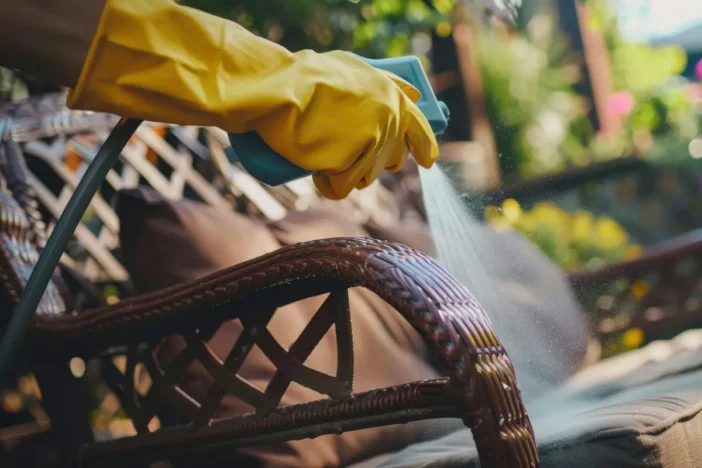
Stay Safe While Cleaning Outdoor Furniture
Cleaning outdoor furniture may seem easy, but it’s important to follow some basic safety steps. This will help protect you and your furniture. Always wear gloves and eye protection to shield yourself from cleaning agents, debris, or splashes. Before using any cleaner, test it on a small, hidden spot of the furniture. This will help you see if it causes discoloration or damage.
If you’re using stronger or chemical-based cleaners, make sure the area is well-ventilated to avoid inhaling fumes. Be careful with pressure washers. They can be effective, but using a high setting can strip paint. It can also damage wood, tear fabric, or dent softer materials. Stick to gentler methods unless you’re sure your furniture can handle the pressure.
We recommend reading through the sections below for insight into cleaning and caring for various outdoor furniture materials.
Guide Sections
Additional ways to maintain and protect deck furniture
If you invested in premium-quality outdoor furniture sets, it makes sense to make them last as long as possible. Keeping everything clean and maintaining them throughout the year are the first steps. The next is to protect your pieces when they’re not in use – during inclement weather or the cold winter months.
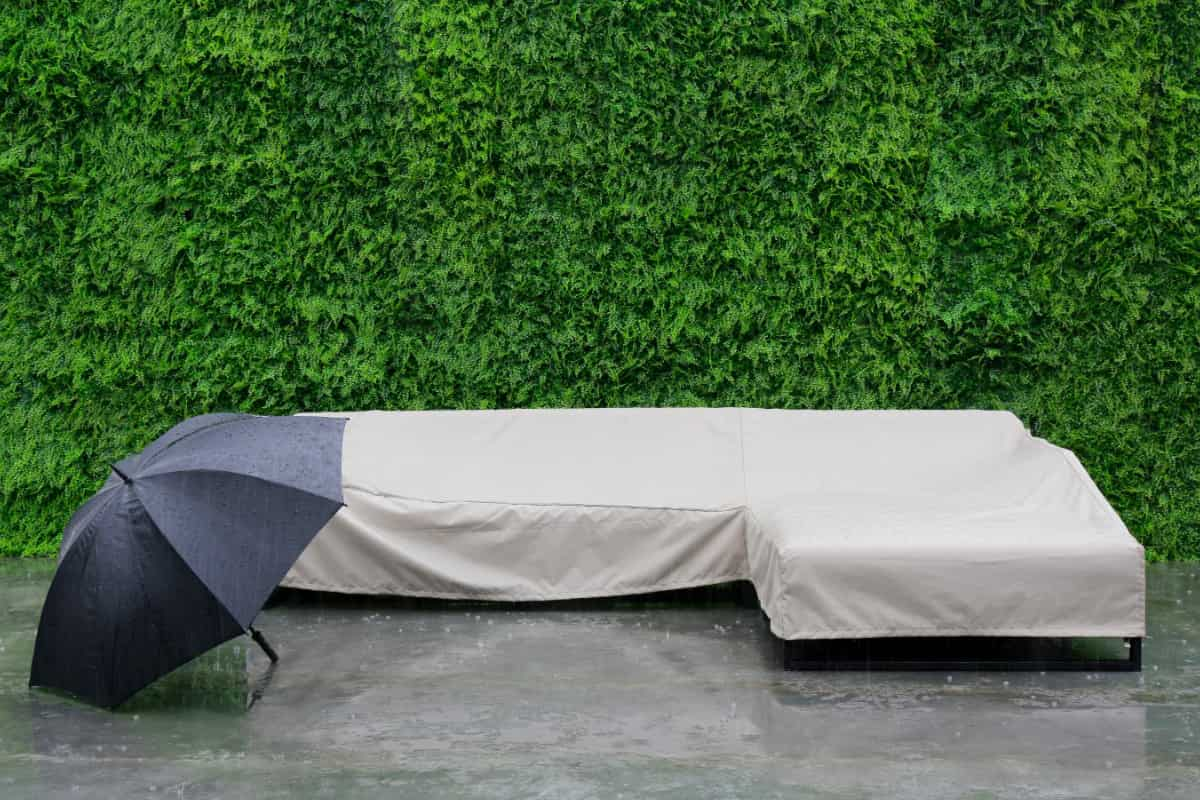
Furniture Covers – Waterproof protection for all seasons
After you clean your garden furniture and protect it from daily use, think about longer-term care. Furniture covers are a great way to shield chairs, tables and patio sofas from rain and fading UV rays when they’re not in use. Covers can also help keep away pests and dust if you store outdoor pieces indoors or in sheltered areas during the winter.
Protective covers are typically waterproof and woven from coated vinyl, canvas or polyester. Generic covers protect various types of furniture that fit within their dimensions. You can even shelter small pool furniture sets beneath a large tarp. They provide adequate protection in most instances but may have issues depending on the fit. Custom-tailored covers fit specific pieces of furniture. Manufacturers offer them to coordinate with particular collections. Their snug fit provides maximum protection but these covers cost more than their generic counterparts.
Whether you choose a generic or custom cover, select one that is water-resistant or waterproof. Ensure it securely fastens and provides adequate ventilation. Continuously wet furniture can develop mold and mildew, rust or wood rot. So, it’s important that protective covers can repel rain, sleet and snow. Good patio furniture covers offer some means of securing the weather-resistant fabric to furniture frames. Tie-downs wrap directly around furniture legs, while elastic straps grip the pieces. Look for covers with built-in vents that allow air to pass through, without exposing the furniture to the elements. Trapped condensation can lead to mold build-up, so letting your items breathe is important.
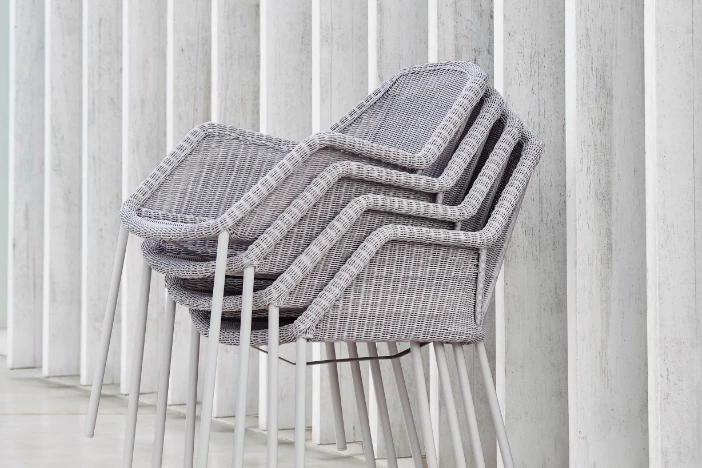
Storage & Shelter – Keeping furniture safe in inclement weather
It’s a good idea to bring your patio furniture inside during the rainy season or when Fall temperatures drop. A little shelter can go a long way toward extending the lifetime of your outdoor seating and tables. Before you store items under your deck, in a shed, or in a garage, make sure they are clean and dry. This is important even if you don’t see any dirt or debris.
Some moisture and bacteria you don’t immediately detect can fester while the pieces are in storage. Warm and humid areas can lead to mold, so you want to find someplace that is cool and dry. Otherwise, you may have additional work to do when the pieces are removed from storage. Ideally elevate the furniture off the ground to avoid damage from standing water, ice or snow.
Several protective sealants on the market can keep outside furniture in tip-top shape over the winter. Apply one to your furnishings if you don’t have a cover or your storage area is exposed.
Use a drop cloth or protective cover to keep the furniture dust-free. Even if you keep items in a shed or a garage, it helps to cover them to prevent scratches. Avoid putting cushions in plastic bags. Use cloth ones or ventilated storage boxes.
Helpful Article
Find more maintenance tips in the finishes and treatments section of our Outdoor Furniture Materials Guide. This will help keep your patio furniture in great condition.
Protect your outdoor furniture investment
Following the cleaning and maintenance recommendations in this guide will help increase the lifespan of your patio furniture. Not only will pieces retain their aesthetic appeal but also their structural and functional integrity. This improves the return on your investment and lessens the need to replace pieces frequently.
Frequently Asked Questions – Cleaning Outdoor Furniture
What is the best way to clean outdoor seating cushions?
The cleaning process for patio furniture upholstery depends on whether or not the cushion covers are removable.
Removable Covers
- Remove the foam insert
- Brush loose soil from the fabric
- Spray or soak the cover in a bucket with warm soapy water until it’s thoroughly soaked
- Scrub the complete cover lightly using a soft-bristled brush to remove minor spills or stains
- Repeat the process on the inside to address stronger stains
- Run clean water over the entire thing inside and outside
- Allow the cover to air-dry completely
- Reinsert the foam core
Non-removable Covers
- Using a sponge, apply soapy warm water to the exterior of the cover
- Work the soap bubbles into the fabric by gently rubbing the surface
- Clean the residual detergent off using a high-pressure hose
- Air-dry the cushions by placing them on their edge
How do you restore greyed teak?
If left untreated, teak will change over time from a warm honey-colored woodgrain to an elegant silver-grey patina. This transition is merely aesthetic and does affect the integrity of the hardwood or its ability to resist the elements outdoors. If you want to restore teak to its original coloration, you can but it takes a little effort.
- Clean the wood – Remove surface grime and dirt with soap and warm water
- Scour it – Using a scrub brush or scouring pad with a gentle cleanser, lightly scour the teak across the grain
- Rinse the teak – Use running water to clear the wood of any loose debris and soapy residue
- Remove stubborn stains – If needed, use a commercial teak cleaner with a strong abrasive and mild acid to get rid of deep stains
- Sand the surface – Use medium to fine sandpaper to smooth out any texture imperfections
- Apply teak oil – Spread teak oil with a soft rag in the direction of the woodgrain
- Apply sealant – Apply one thin coat of sealer and allow it to dry before applying a second

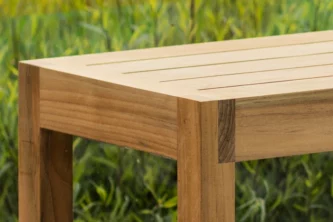
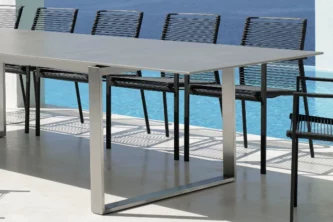
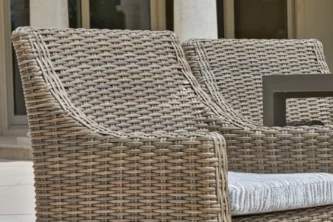
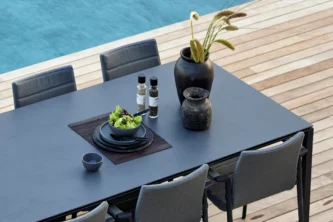
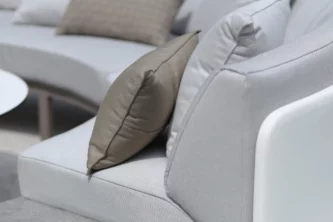





I think you are right to use a microfiber cloth on wooden and glass furniture. I need to get a new patio set. I’ll have to consider getting a set that is easy to wipe down for dust control.
One reason for resin wicker’s popularity is its easy upkeep. Just wipe down with a damp cloth, soapy or not—or pull out the hose for a tough job. This type of furniture is often used in sunrooms, as well as on patios and deck areas. Companies sometimes recommend that these outdoor sets remain covered when not in use to protect the plastic resin from UV damage, which will eventually lead to deterioration or breakage.
Great point!
To quote The Graduate, “I’ve got one word for you, Benjamin – plastics.”
In coastal environments (where there is usually a high concentration of abrasive salt in the atmosphere) aluminium furniture should be washed down with fresh water and covered when not in use.
I want to make sure that my grill is okay on my patio during the winter. It makes sense that I might want to keep it covered so that the snow doesn’t damage it. I’ll have to see if I can get a cover for it.
Depending on the grill type, the manufacturer may have covers available. If you have a built-in grill, you might have to custom order one to fit your particular configuration. Otherwise, a permanent awning might be a good option if you cannot roll the grill into a more protected area.